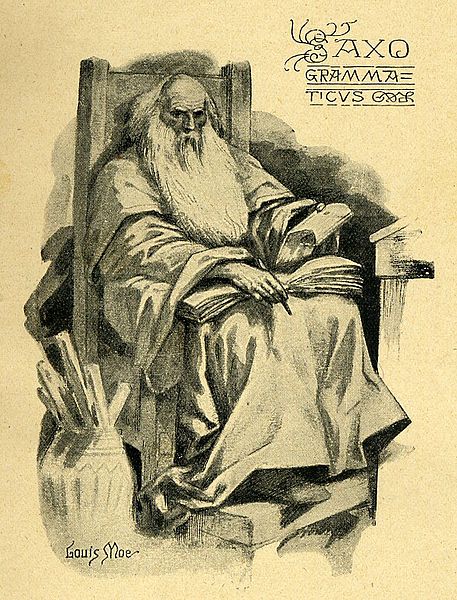Saxo, who lived in the latter part of the twelfth and early thirteenth centuries, was probably a canon of Lund Cathedral (then Danish). He was secretary to Archbishop Abslon, who encouraged his gifted protégé to write a history of his own country to emulate those of other nations, such as Bede’s Ecclesiastical History of the English People. Absalon was able to supply him with a large amount of material for the last few of the 16 books, since, as a warrior archbishop, he had taken a leading part in the Danish campaigns against the Wends of North Germany.
The work is a prosimetrum: in the prose text of six of the first nine books he inserts poems, some quite substantial. The poetry, he tells us, are meant to put into metrical Latin verse some of the narratives he had found in old Danish (and probably Icelandic) heroic poetry, such as the courageous last stand of Biarki and Hialti defending their lord after a Swedish ambush on the royal palace. He begins his work with the ancient myths and legends. Only in Book Nine does he start to introduce recognizable historical figures, after which he proceeds through the lives and activities of Viking kings, like Cnut the Great, ending in 1185 with the earlier exploits of Cnut Valdemarson.

As the first major Danish historiographer, Saxo’s work is a valuable fund of material, even though, like many other medieval historians, his accuracy can be variable, sometimes to the extent of invented episodes. Nevertheless, he is the only source available for the period in places. Needless to say, he favours the Danes against neighbouring nations like the Swedes and Germans (we read a great deal about the treachery of the Holy Roman emperors), and he is keen to trace the rise and spread of Christianity in Scandinavia.
The Gesta Danorum is also the first outstanding work of Danish literature. Although his general style is elegant and complex, he is a consummate story-teller, and when he gets his teeth into a good yarn, he can relate it in a swift and lively manner. These narratives range from heroic tales like those told of the tough old warrior Starkath (who loathes German sausages), to the tender love stories in Book Seven, and the early books are full of dragons, witches, wizards, and tales of the supernatural, including one about a vampire. He often displays a wry sense of humour, as in the story about a drunkard who persistently defies the king’s edict forbidding the brewing and consumption of beer. One of Saxo’s claims to literary importance is his inclusion of the first-known version of the Hamlet story. The fortunes of his Amleth foreshadow those of Shakespeare’s hero in surprising detail.
Whatever his merits as a historian, and they are many, Saxo always provides a good read, and generations of Danish children have been entertained by his tales at their mother’s knee.
The post Who was Saxo Grammaticus? appeared first on OUPblog.



